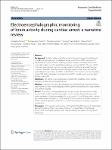Item Infomation
Full metadata record
| DC Field | Value | Language |
|---|---|---|
| dc.contributor.author | Elisabetta, Roberti | - |
| dc.contributor.author | Giovanni, Chiarini | - |
| dc.contributor.author | Nicola, Latronico | - |
| dc.date.accessioned | 2023-03-28T07:27:20Z | - |
| dc.date.available | 2023-03-28T07:27:20Z | - |
| dc.date.issued | 2023 | - |
| dc.identifier.uri | https://link.springer.com/article/10.1186/s40635-022-00489-w | - |
| dc.identifier.uri | https://dlib.phenikaa-uni.edu.vn/handle/PNK/7228 | - |
| dc.description | CC BY | vi |
| dc.description.abstract | To date cardiac arrest (CA) remains a frequent cause of morbidity and mortality: despite advances in cardiopulmonary resuscitation (CPR), survival is still burdened by hypoxic–ischemic brain injury (HIBI), and poor neurological outcome, eventually leading to withdrawal of life sustaining treatment (WLST). The aim of CPR is cardiac pump support to preserve organ perfusion, until normal cardiac function is restored. However, clinical parameters of target organ end-perfusion during CPR, particularly brain perfusion, are still to be identified. In this context, electroencephalography (EEG) and its derivatives, such as processed EEG, could be used to assess brain function during CA. | vi |
| dc.language.iso | en | vi |
| dc.publisher | Springer | vi |
| dc.subject | cardiac arrest | vi |
| dc.subject | cardiopulmonary resuscitation | vi |
| dc.title | Electroencephalographic monitoring of brain activity during cardiac arrest: a narrative review | vi |
| dc.type | Book | vi |
| Appears in Collections | ||
| OER- Y học- Điều dưỡng | ||
Files in This Item:

